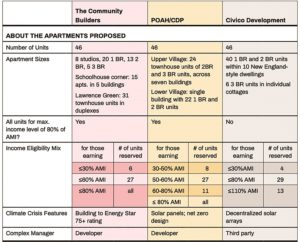WELLFLEET — The committee charged with rating the would-be developers of 46 affordable apartments at 95 Lawrence Road hopes to clarify a few details with the three groups that submitted proposals as the panel heads into the home stretch.
Meanwhile, the nonprofit Preservation of Affordable Housing (POAH), which is partnering with the local nonprofit Community Development Partnership (CDP), appears to be solidifying its position as frontrunner among the eight-member Lawrence Road Task Force.
One member of the task force, Jan Plaue, has already announced her choice, because she would be unable to attend some upcoming meetings of the group. She voted for POAH-CDP.
“I think all three were worthy proposals,” said Plaue, “but none of them was fully compliant with the RFP. One of the most important things to me was that our vision for this project was to give homes to people who truly cannot afford to live in Wellfleet but work here or do good services. As much as I hate their great big building, I’ve chosen POAH.”

Plaue had rated the POAH proposal Unacceptable, the lowest score, for both site and building design a few weeks earlier.
The request for proposals for the Lawrence Road project set the range of affordability between 30 and 120 percent of the Area Median Income (AMI), but stipulated that proposals with larger numbers at or below 80 percent of AMI would be ranked more favorably.
POAH had the largest number of units for those who earn the least, Plaue pointed out.
Three proposals for 46 affordable rental units are under review by the task force. The POAH-CDP partnership proposed a $20.2-million plan in which all units would be rented to tenants earning 80 percent or less of the AMI. And 35 of those units would go to tenants earning no more than 60 percent of the AMI.
The Community Builders, another nonprofit, proposed a $19.3-million plan that also had all of the units designed for households at or below 80 percent of the AMI. Of the total, 33 units would go to those at or below 60 percent — two units fewer than POAH proposed.
Civico Development’s $14.6-million plan assigned four units to tenants making 30 percent or less of the AMI. Of the 46-unit total, 33 would be for tenants earning 80 percent or less of the AMI. The remaining 13 units would be for tenants earning up to 110 percent. Civico characterized its proposal as focusing on “workforce housing.”
The task force canceled its meetings that had been scheduled for Oct. 1 and Oct. 15, and had no meetings scheduled at press time this week, since the review of the developers’ financial plans had not been completed.
The task force had expected to make its final recommendation to the select board on Oct. 26, but the date will likely be pushed back to early November, said chair Elaine McIlroy in an email.
Meanwhile, the task force wants the relationship between Preservation of Affordable Housing and the Community Development Partnership to be spelled out more clearly. The members want to know whether they will jointly own the development, or whether POAH will be sole owner. Initially, it had appeared as if CDP was simply partnering during the permitting stage of the project. Later discussions indicated that the CDP might have part ownership.
McIlroy thought that was an important detail to nail down. But task force member Harry Terkanian didn’t. “It wouldn’t bother me if POAH was the sole owner or CDP was the sole owner,” he said during the group’s last meeting, held in September.
Kathleen Bacon said she had “great concern” over the relationship of the two nonprofits because they could have a falling out at some point. Although McIlroy wanted more clarity, she said that POAH tends to choose local partners. In other Cape projects, POAH partnered “very successfully” with the Housing Assistance Corp., McIlroy said.
The task force planned to send a letter to all three bidders asking them to elaborate on their organizational structures for the Wellfleet project. “My general concern is that this is our one shot at this,” said Gary Sorkin, who had suggested contacting all three.
The task force also decided to go beyond the lists of references that had been supplied by the bidders. All three groups received stellar recommendations. The task force members planned to contact others outside those lists, such as town planners.
Bacon urged her fellow committee members to review the comments from a community forum last January before they take their final vote. “Going forward, my biggest concern is not so much who we pick but how that developer fits in with the neighborhood,” Bacon said.



